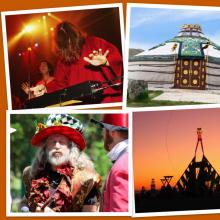art installation
Suzanne Brennan Firstenberg, creator of “In America: Remember,” is a social practice artist in the Washington, D.C., area. She spoke with Sojourners' Jenna Barnett.
“[‘IN AMERICA: REMEMBER’] was a vast field of flags: one for each person who died from COVID-19. The installation began [in mid-September] when there were 666,624 deaths. Each day, I changed the number on the large sign. When the installation closed [in early October], there were 701,133 deaths.
People came thousands of miles to write words on 5-by-4-inch poly film attached to a steel stem. Each time somebody dedicated a flag, they were my co-artists. To have the privilege of watching strangers console strangers—that was the magic of the place. It was important to us to make sure that people had equal access to this art. Many people who had suffered losses could not afford the time or the expense of coming. So, we announced that the art was coming two months in advance so that people could plan. And we made sure that people could dedicate flags through our website.
PRE-EXPERIENCE: Welcome! You’re alone except for a receptionist, who gently asks you to sign a waiver and gestures to the couch. The sand-colored cushions perfectly complement the soft pink glow of the wall and a pot of shellacked succulents. The coffee is pleasantly warm. The room temperature is perfect. Everything is fine.
You’re here for “Carne y Arena,” a virtual reality experience created by Mexican filmmaker Alejandro G. Iñárritu. The project recreates the experiences of immigrants who cross the Mexico-U.S. border. In 2017, “Carne y Arena” (“Flesh and Sand”) won a Special Award Oscar, the first given for virtual reality. The exhibit accommodates only one visitor at a time, at 15-minute intervals.
You wait on the couch, feeling a twinge of anxiety over an immersive experience that requires isolation and allows no cameras or notebooks. You contemplate the Pinterest-nirvana of the lobby and scratch a few notes while you can.
Entry: So where are we, exactly?
Soon, you’re escorted through the doors of the exhibit, which is housed in an old Baptist church in a gentrifying neighborhood in Washington, D.C. The project will take place across three rooms, a triptych of the migrant experience.
The church was slated for demolition before “Carne y Arena.” On the way in, you pass walls that look strangely familiar—you’ll later realize they are repurposed fence panels from the U.S.-Mexico border, turned horizontal to fit the dimensions of the house of God. You’re pretty sure that works as a metaphor, but before you can chew on it, you’re inside.
Last year, Phil Wyman, pastor of The Gathering church in Salem, Mass., trekked across the country with five adventurous friends to Burning Man — a week-long event described by its attendees as "an experiment in community, art, radical self-expression, and radical self-reliance" in the Black Rock desert of Nevada.
At the 2011 Burning Man, Wyman and his merry band of "crazy friends" built an art installation called "The Pillars of the Saints" — three meditation towers constructed of wood in the desert, asked people to sit on top of them, listen for a voice (presumably of the Holy), and write what they heard on the walls of the pillars.
This year, Wyman (who you might recognize from photos at the Wild Goose Festival last month where he played the "Holy Fool" in a Sunday morning worship service), has invited more than 15 friends to join him in the Nevada desert at the end of August for Burning Man 2012 where the group plans to build another art installation — this one even more ambitious and whimsical than the last.
Wyman & Co., have christened it "Theophony: The Mighty Interactive Faux Theremin." It involves an enormous, specially-built theremin placed at the center of a 32-foot canvas-and-wood yurt, with walls comprised of a series of 22 four-by-eight-foot murals with themes reflecting the "success and failures of spiritual pursuit."
"The particpant will feel a sense of dissonance while trying to 'play' the theremin," in tune with the chants and ambient music piped through the yurt, Wyman explains. The idea of Theophony is "to illustrate that spiritual pursuit is a discipline, but that even the imperfect attempt is both holy and fun."


